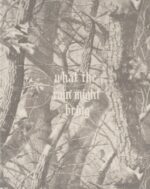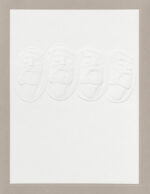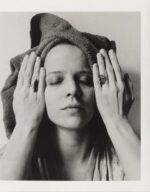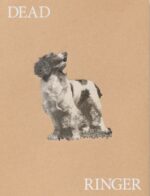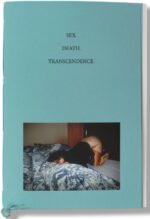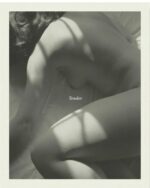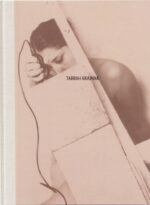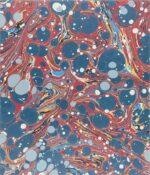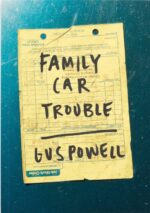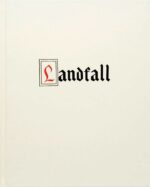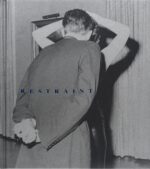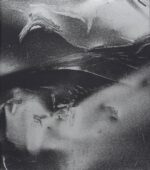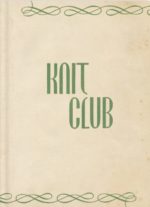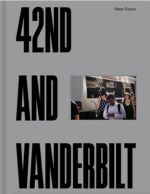TBW Books
-
Dylan Hausthor : What the rain might bring
What the Rain Might Bring est la première publication du photographe Dylan Hausthor.
Conçu comme une œuvre d’art à part entière, le livre est encadré – bord noir et dos imprimé – et totalement dépourvu de texte avec seulement un titre simple sur sa couverture. Le design minimaliste ouvre la voie à une expérience sensorielle immersive qui mêle le tactile et le visuel, attirant les lecteurs dans un monde imprégné de mysticisme.What the Rain Might Bring is the debut release from photographer Dylan Hausthor. Designed as a work of art in its own right, the book features a frame—black edge and spine printing—and is completely devoid of text with only a simple title on its cover. The minimalist design sets the stage for an immersive sensory experience that intertwines the tactile and the visual, drawing readers into a world steeped in mysticism.
-
Peter Funch : 42nd and Vanderbilt
Entre 8 h 30 et 9 h 30, de 2007 à 2016, au coin sud de la 42e rue et de l’avenue Vanderbilt à New York.
Between 8:30 am and 9:30 am, from 2007 to 2016, at the southern corner of 42nd Street and Vanderbilt Avenue in New York City.
Le photographe danois Peter Funch a placé ces limites rigides sur son projet photographique de 9 ans, 42nd et Vanderbilt. Réduisant les opportunités infinies que NYC a à offrir à un artiste, Funch fait remonter à la surface les minuties contenues dans un fragment de notre routine quotidienne, la courte promenade du point A au point B, nous rappelant que la pratique de la photographie en général et de la photographie de rue spécifiquement, n’a fait qu’effleurer la surface de la possibilité.
Danish photographer, Peter Funch, placed these rigid confines upon his 9 year photographic project, 42nd and Vanderbilt. Narrowing the infinite opportunities NYC has to offer an artist, Funch brings to the surface the minutiae contained within a fragment of our daily routine, the short walk from Point A to Point B, reminding us that the practice of photography in general, and street photography specifically, has only scratched the surface of possibility.
-
Carolyn Drake : Untitled Men
78,00€Exemplaire Signé / Signed Copy.
Carolyn Drake a reçu le prix HCB 2021 de la Fondation Henri Cartier-Bresson pour produire cette série de photographies. Chaque livre est signé par l’artiste et imprimé en édition limitée à 1500 exemplaires.
Carolyn Drake was awarded the 2021 HCB Award by the Fondation Henri Cartier-Bresson to produce this series of photographs. With a row of embossed white faces tipped on the cover, each book is signed by the artist and printed in a limited edition of 1,500 copies.
Publié à l’occasion de l’exposition à la Fondation Henri Cartier-Bresson (HCB) du 19 septembre 2023 au 14 janvier 2024.
Published on the occasion of the exhibition at the Fondation Henri Cartier-Bresson (HCB) from 19 September, 2023 to 14 January 2024.
-
Melissa Shook : Daily Self-Portraits ; 1972-1973
« Il était important de laisser mon inconscient, plutôt que mon intellect, dicter la progression. Pour des raisons que je ne comprends pas tout à fait, le fait d’être nu a fait partie du projet très tôt. Et travailler contre ce mur blanc, près des deux fenêtres avant dans le soi-disant salon, est devenu un point central. » -Melissa Shook
« It was important to let my unconscious, rather than my intellect, dictate the progression. For reasons I don’t entirely understand, being nude became part of the project early on. And working against that white wall, near the two front windows in the so-called living room, became a central point. » -Melissa Shook
-
Mary Frey : My Mother, My Son
En utilisant le titre de sa photographie de 2004, My Mother, My Son, comme point de départ inspirant et créatif, Mary Frey puise dans ses vastes archives de photographies pour créer une histoire picturale qui s’effondre dans le temps linéaire.
Using the title of her 2004 photograph, My Mother, My Son, as an inspirational and creative starting point, Mary Frey pulls from her vast archive of photographs to create a pictorial story collapsing linear time.
-
Yael Eban & Matthew Gamber : Dead Ringer
58,00€Dans ce monde numérique, la tactilité du passé imprimé devient de plus en plus intrigante. Considérer où sont toutes ces photos, où elles vont, et ce qu’elles signifient, c’est puiser dans des histoires humaines sans fin, grandes et petites. Aujourd’hui, il y a presque trop d’images à traiter, à comprendre ou à accorder une attention appropriée. Même ainsi, au cours des cent dernières années, un merveilleux trésor a été laissé derrière avec lequel les artistes peuvent créer de nouveaux mondes. Fétichiser et réévaluer les photos vintage et vernaculaires a une tradition bien ancrée. Trouver de nouvelles idées et des perspectives uniques sur le genre est rare. Mais encore plus rare est de trouver des images disparates qui ont eu des voyages séparés autour du monde pour se réunir ici dans cette collection.
In this digital world the tactility of the printed past becomes ever more intriguing. To consider where all these photos are, where they go, and what they mean is to tap into endless human histories, both big and small. Today there are almost too many images to process, make sense of, or to give proper attention. Even so, over the last one hundred plus years a wonderful trove has been left behind with which artists can create new worlds. Fetishizing and reevaluating vintage, vernacular photos has a well-trodden tradition. To find new insights and unique perspectives on the genre is rare. But even rarer is to find disparate images that have had separate journeys around the world only to reconvene back here in this collection. -
Linda Troeller : Sex, Death, Transcendence
Au fil des ans, j’ai vu que le corps doit être examiné, déplacé, réengagé, retrouvé, ré-adressé parce que c’est une voie si puissante vers les photographies intimes et un contact surréaliste avec le grand au-delà. » -Linda Troeller
« Over the years, I saw that the body must be examined, moved, re-engaged, re-found, re-addressed because it is such a powerful route to intimate photographs and a surreal contact with the great beyond. »-Linda Troeller
-
Peggy Nolan : Juggling is Easy
Voilà à quoi cela ressemble quand une mère dans le sud de la Floride élève sept enfants toute seule tout en photographiant chacun de leurs mouvements.
What it looks like when a mother in South Florida raises seven kids on her own while photographing their every move.
“Between 1967 and 1982, I gave birth to seven children. All are still alive and not a single tattoo.”-Peggy Nolan
-
Carla Williams : Tender
Numéroté sur 1 500 & Signé par la photographe et comprend un tirage original (10 x 15 cm).
Numbered on 1500 & Signed by the photographer and includes an original chromogenic print (4 x 6 inch).
Tender est la première monographie de l’artiste Carla Williams. Réalisées en privé entre 1984 et 1999 et conservées pour la plupart pour elle-même pendant plus de trente ans, les images de Tender constituent un autoportrait complet et personnel d’une jeune femme noire queer explorant intimement le domaine de ses propres possibilités.
Tender is the first monograph by artist Carla Williams.
Made in private between 1984 and 1999 and kept mostly to herself for more than thirty years, the images in Tender comprise a complete, personal self-portrait of a young, queer, Black woman intimately exploring the realm of her own possibility. -
Tarrah Krajnak : Master Rituals II ; Weston’s Nudes
1ère édition de 500 exemplaires, signée et numérotée par l’artiste.
1st edition of 500 copies, signed and numbered by the artist.
En déconstruisant les nus d’Edward Weston sous forme d’autoportraits, l’artiste Tarrah Krajnak s’insère à la fois comme auteur et comme sujet dans l’œuvre originale d’Edward Weston.
Deconstructing Edward Weston’s Nudes in the form of self-portraits, the artist Tarrah Krajnak inserts herself as both author and subject into Weston’s original work.
-
Gus Powell : Family Car Trouble
Avec Family Car Trouble, Gus Powell joue avec la forme du roman, à la fois comme objet matériel et comme véhicule narratif pour exprimer la vie intérieure.
With Family Car Trouble, Gus Powell plays with the form of the novel, both as material object and as narrative vehicle for expressing interior life.
-
Mimi Plumb : Landfall
Mimi Plumb’s Landfall résume les angoisses d’un monde en perte d’équilibre, un pays miroir qui rappelle étrangement notre époque.
Mimi Plumb’s Landfall encapsulates the anxieties of a world spinning out of balance, a mirror-land eerily reminiscent of our own time.
-
Ken Graves and Eva Lipman : Restraint and Desire
Restraint and Desire est l’aboutissement d’un partenariat créatif à vie entre le mari et la femme Ken Graves et Eva Lipman, dont la vie visionnaire a été définie par l’acte unique et désintéressé de revendiquer le crédit artistique comme une entité unique.
Restraint and Desire is the culmination of a lifelong creative partnership between husband and wife Ken Graves and Eva Lipman, whose visionary life together was defined by the unique and selfless act of claiming artistic credit as a singular entity.
-
Ken Graves and Eva Lipman : Derby
Les derbies sont chaotiques, un nihilisme ritualisé de destruction automobile, de métal et de boue partout, mais dans le Derby de Ken Graves et Eva Lipman, une poésie discrète émerge de la scène.
The derbies are chaotic, a ritualized nihilism of automotive destruction, metal and mud everywhere, but in Ken Graves and Eva Lipman’s Derby, an understated poetry emerges from the scene.
-
-

